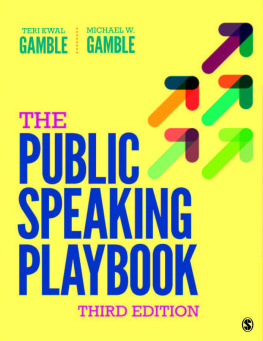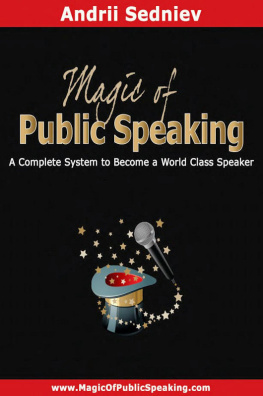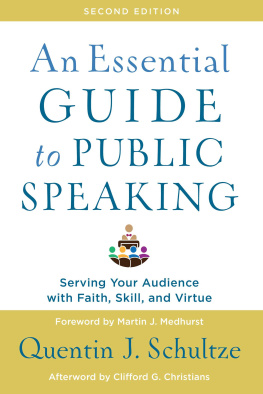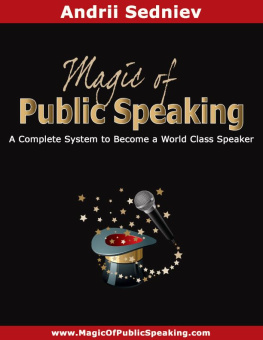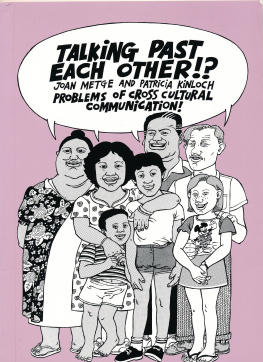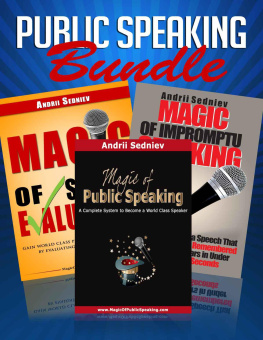Glossary
AbstractionSomething that is vague; language that is neither concrete nor specificAffirmative sideThe pro side in a debate; the side speaking in support of a resolutioncalling for changeAfter-dinner speechA speech that is relevant to the occasion and designed to entertainAgeist languageLanguage that discriminates on the basis of ageAlliterationRepetition of the initial consonant sounds in nearby wordsAntithesisThe presence of opposites within the same or adjoining sentences; thejuxtaposition of opposing ideasArgument
ad hominemName-calling; the use of offensive and insulting words to win anargumentArticulationThe act of producing individual soundsAsynchronous presentationAn online presentation that is recorded and then viewed at another timeAttendingThe listening stage during which an individual selects to pay attention toone or more specific aural stimuliAttitudeA mental set or predisposition to respond to something favorably orunfavorably; a readiness to respond positively or negativelyAudience analysisThe systematic identification of the demographic and psychographiccharacteristics of an audience to determine member interests andmotivationBandwagon appealAn appeal to popular opinionBar graphA type of graph used to compare or contrast two or more items or groupsBehavioral objectiveA desired specific speech outcome; a desired observable and measurableaudience responseBeliefThat which one holds to be true or false, probable or improbableBody of the speechThat portion of the speech made up of and elaborated by the speechs mainpointsBrainstormingA system of idea generation devised by Alex OsborneBriefingA short talk providing those with a stake in the outcome a summary of whathas been done or still needs to be done to complete a projectCausal reasoningReasoning that unites two or more events to prove that one or more of themcaused the otherCausal transitionsTransitions that help show the cause-and-effect relationships betweenideasCause-and-effect orderAn organizational pattern in which information is categorized according towhether it is related to a problems causes or effectsCenteringThe directing of thoughts internally via a deep or centering breathCentering breathA deep breath followed by a strong exhalationCentral ideaThe topic statement of a speechChannelA pathway through which a message passesChartA visual aid used to compress or summarize a large amount ofinformationChronological orderAn organizational format based around time or the order in which thingshappenChronological transitionsTransitions that help in understanding the time relationship betweenideasClaimAn assertion made in arguing; a debatable conclusionClosed-ended questionsHighly structured questions requiring only that the respondent indicatewhich of the provided responses most accurately reflects his or her answerto a questionClosed questionA highly structured question seeking a short and precise answer such as yesor noClosureA technique designed to achieve psychological symmetry or balance; thespeaker refers in the conclusion of a speech to the same ideas exploredduring the speechs beginningCo-cultureA group of people who share a culture outside of the dominant cultureCognitive restructuringA technique designed to redirect thinking away from body sensations andirrational beliefs to beliefs that promote growthCommencement addressA speech given to a graduating classCommon groundThe concerns and interests shared by the speaker and the audienceCommunicationA process that involves the attempted sharing of information; the means bywhich people generate meaningComplementary transitionsTransitions that help the speaker add one idea to the nextComputer-generated graphicsThe use of technology in creating graphicsConcreteA description attributed to words that evoke precise meaning; language thatis free of jargonConclusionThe ending of a speech; designed to reinforce the central idea or thesis,motivate an appropriate audience response, and achieve closureConfigural formatsListener-responsible organizational formats in which examples and storiescarry the crux of a messageConnotative meaningPersonal meaning; meaning that is subjective and variableContrasting transitionsTransitions that show how the idea that follows differs from the ones thatprecede itCoordinate pointsPoints in an outline that are of equal weight or substanceCoordinationThe principle establishing that main points should be relatively equal inimportanceCovert lieAn unspoken lie; a lie designed to conceal sensitive information that needsto be said but isntCredibilityAudience judgments of a speakers competence, character, and charismaCritical thinkingThe process of arriving at a judgment only after an honest evaluation ofalternatives; the exhibiting of careful and deliberate evaluation of aclaimCultural diversityThe recognition and valuing of differenceCultural identityThe internalization of culturally appropriate beliefs, values, and rolesacquired through interacting with members of a cultural group; a product ofgroup membershipCultureThe system of knowledge, beliefs, values, attitudes, behavior, and artifactsthat the members of a society learn, accept, and use in daily lifeDebateA form of argument in which two sides take turns presenting pro and conpositions, with each side competing to win adherentsDecision-making groupA group whose members seek a consensus regarding what the group should orshould not do to solve a problemDeductive reasoningReasoning that takes a known idea or principle and applies it to asituation; reasoning that moves from the general to the specificDeferred-thesis patternA kind of configural format in which the main points of a speech graduallybuild to the speakers thesisDefinitionsStatements used to clarify the meaning of words and conceptsDemographic profileA composite of audience characteristics including age; gender; educationallevel; racial, ethnic, or cultural ties; group affiliations; andsocioeconomic backgroundDenotative meaningThe dictionary meaning of a wordDerived credibilityAudience perception of a speakers credibility during the giving of aspeechDescriptionsWords that evoke fresh imagery or sensory responseDialectA speech pattern characteristic of a group of people from a particular areaor of a specific ethnicityDrawings and mapsVisual aids used to illustrate differences, movements, or geographicinformationEarly concurrenceThe tendency to conclude discussion prematurelyEffects of communicationCommunication outcomesEmblemsNonverbal symbols with direct translations that are culturally learnedEthical communicationCommunication that presents ideas fairly; the revealing of informationreceivers need to assess both the message and speaker criticallyEthical speechmakingSpeech that involves the responsible handling of information and anawareness of the outcomes or consequences of a speechEthicsAn exploration of how values distinguish actions; a societys notions aboutthe rightness and wrongness of behaviorEthnocentricityA belief that ones culture is better than othersEthnocentrismJudging another culture solely by the standards of your own cultureEthosThe ability to convince the audience of your good character orcredibilityEulogyA special form of tribute speech that pays tribute to a deceased person,usually given at a gravesite or at a memorial serviceEuphemismAn indirect expression that makes it easier to handle unpleasantsubjectsEvaluatingThe process of using critical thinking skills to weigh a messagesworthEvent/person speechA speech designed around a remarkable person or compelling eventEvidenceMaterial used to validate a claimExpert testimonyTestimony provided by sources recognized as authorities on the topicExplanationsClarifying wordsExtemporaneous outlineAn outline containing brief notes, also known as speaker notes, to remindthe speaker of key parts of the speech and referencesExtemporaneous speakingSpeaking that is planned and rehearsed but delivered using only a fewnotesFact-finding groupA group whose members share thoughts and information to enhanceunderstanding and learningFalse dichotomyA proposition that requires the audience to choose between two options whenin reality there are manyFalse divisionA false statement suggesting that if something is true of the whole, it isalso true of one or more of the partsFeedbackInformation received in response to a sent messageField of experienceThe sum of all experiences; the attitudes, values, and lessons one brings toa situationFigurative analogyAn analogy comparing two things that are distinctively dissimilarFigurative languageWords that facilitate the picturing of meaningFraming theoryA theory focusing on the shaping of experience to promote aninterpretationGeneral purposeThe overall purpose of a speech, such as to inform, persuade, orentertainGlittering generalityThe use of positive association designed to encourage idea acceptanceGraphsVisual aids that are designed to communicate statistical information,illustrate trends, and/or demonstrate patternsGroupthinkThe tendency to let a desire for consensus override careful analysis andreasoned decision makingHasty generalizationThe act of being too quick to draw an inference; jumping to a conclusion onthe basis of too little evidenceHealthy groupA group in which members support one another, make decisions together, trustone another, have open communication, and aim to excelHearingAn involuntary physiological processHeterogeneous audienceAn audience whose members possess dissimilar characteristics, rich in age,attitude, value, and knowledge diversityHigh-context communicationCommunication that avoids confrontation; communication that relies onindirect messagesHomogeneous audienceAn audience whose members possess similar characteristics, such as age,attitude, value, and knowledge similarityHuman visual aidThe use of a real person as a visual or audio aidHyperboleExtreme exaggerationHypothetical examplesExamples that have not actually occurred but mightIdea/concept speechA speech given to explain or define something intangible or abstractI languageLanguage of responsibility and ownershipIllustrationsExtended examples or narrativesIllustratorsGestures to reinforce, clarify, describe, and demonstrate the meaning ofyour wordsImmediacyA sense of closenessImpromptu speakingSpeaking that is off the cuff and accomplished with little or nonoticeInductive reasoningReasoning that relies on observation and specific instances to build anargument; reasoning progressing from specific observations to aconclusionInfographicA composite of information, illustration, and designInformation overloadBeing given too much information to process or handleInformation underloadBeing given too little information; underestimating the amount ofinformation neededInformative speechA speech designed to impart new information, a new skill, or a fresh way ofthinking about somethingInitial credibilityThe receivers perception of a speakers credibility prior to his or herspeakingInternal previewA speech segment that helps the speaker hold a speech together, byindicating what to look for as a speech progressesInternal summaryA speech segment that helps the speaker clarify or emphasize what wassaidInterpretingA listening stage during which the focus is on meaning and the decoding ofthe speakers messageInterviewA meeting during which questions are asked and answered by both interviewerand intervieweeIntroductionThe opening of a speech; designed to capture the audiences attention, buildcredibility, orient receivers to what is to followJargon and technospeakTypes of specialized language clear only to people with specificknowledgeKeynote addressA speech usually given at a conference and designed to generate enthusiasmfor and commitment to a desired outcomeKinesicsThe study of body language or human body motion, including gestures, bodymovements, facial expressions, eye behavior, and postureLay testimonyPeer testimony, the opinions of ordinary peopleLinear formatsSpeech formats by which the main points relate to the topic sentenceLine graphA graph that shows trends over timeListeningA voluntary mental process occurring in stagesLiteral analogyAn analogy comparing two things from similar classesLogical fallacyA flawed reasonLogosLogical proof demonstrating the reasonableness of argument(s)Low-context communicationCommunication that is direct and addresses issues head-onMain pointsThe central themes of a speech; the key ideas that serve as the outlinesframework; the subtopics directly supporting the thesisMaintenance leadership behaviorsRoles focused on maintaining the group, including expressing agreement andsupportManuscript readingA speech in which the speaker delivers a written manuscript word forwordMarginalized groupA group whose members feel like outsidersMaslows Hierarchy of NeedsA pyramid progressing from the most basic to the most sophisticated humanneedsMessageThe content of communicationMetaphorA direct comparison between two things or ideasMonroes Motivated SequenceAn organizational framework particularly effective in moving receiverstoward accepting and acting on a proposition of policyNarrativeAn extended example or illustration; a story describing what people aredoing and whyNarrative patternA configural format in which the speaker tells a story or series of storieswithout stating a thesis or identifying main pointsNegative sideThe side in a debate seeking to maintain the status quoNoiseAnything that interferes with the ability to send or receive a messageObject speechA speech about something tangibleOne-sided presentationA presentation offering only a single perspective on an issueOnomatopoeiaA word or words that imitate natural soundsOpen-ended questionsQuestions allowing a respondent to answer fully and in his or her ownwordsOpen questionA question offering freedom in answering by calling for more than a one-wordresponseOutlineA speech skeleton on which main ideas and support are hungOvert lieA deliberate lie; a distortion of the factsParalinguisticsThe study of messages sent using vocal cuesParallelismWords, phrases, or sentences that parallel or balance each other; repetitionof words, phrases, or sentencesParaphraseRestating material in your own wordsPathosThe ability to develop empathy and passion in othersPeer testimonyTestimony provided by lay or ordinary people who possess firsthandexperience on a subjectPerformance anxietyA variant of communication anxiety; fear of presenting a speechPersuasionThe deliberate attempt to change or reinforce attitudes, beliefs, values, orbehaviorPictographA simplified infographic; a pictorial representation of a graphssubjectPie graphA graph used to illustrate percentages of a whole or distributionpatternsPitchThe highness or lowness of the voice on a tonal scale; a voices upward ordownward inflectionPitch, aA kind of persuasive or sales presentation during which the speaker attemptsto obtain an endorsement for a proposalPlagiarismThe deliberate or accidental claiming of anothers words or ideas as onesownPodcastA digital audio recording accessible to Web usersPolitical correctnessThe act of using words that are polite and convey respect for the needs andinterests of different groupsPosition presentationA presentation in which the speaker delivers a persuasive argument on acontroversial issuePoster presentationA graphically based approach to presenting information or researchPost hoc, ergo propter hocA logical fallacy asserting that because one event preceded another, itcaused itPresentation aidsAudio and visual stimuli that support and enhance speech contentPrimacyrecency factorThe tendency to remember information that is placed at the beginning and endof a speech better than the information that is placed in the middle of thespeechPrimary questionA question that introduces a topic or area for explorationPrimary researchOriginal research involving the collection of firsthand dataProbing questionA question that seeks more informationProblemsolution orderAn organizational format that divides information into two main parts, theproblem and its solutionProcedural behaviorsActivities a leader performs that help facilitate conducting the groupsbusinessProcess anxietyFear of preparing a speechProcess/procedure speechA speech designed to convey how something works or how to do somethingPronunciationThe accepted way to sound a word; identifying whether the production of theindividual sounds used to form a word is correctPropositionThe relationship the speaker wishes to establish between accepted facts andhis or her desired conclusionsProposition of factAn assertion that something does or does not exist, is or is not true, or isor is not of value; an effort to prove something factualProposition of policyA recommendation for change or no change; a type of persuasive speechfocusing on what the speaker thinks should be doneProposition of valueAn assertion of a statements worth; a type of persuasive speech rendering ajudgment about somethingProxemicsThe study of space and distance in communicationPsychographicsA description of values, beliefs, and interests, including how members of anaudience see themselves, their attitudes, and motivesPublic speaking anxietyA variant of communication anxiety, made up of process and performanceanxietyQ&AA question-and-answer sessionRacist languageLanguage discriminatory toward the members of a race; words that expressbigoted viewsRateThe speed at which words are spokenReasoning from analogyThe process of comparing like things and concluding that because they arecomparable in a number of ways, they also are comparable in another, newrespectReasons approachThe presentation of reasons to justify a speechs goalReceiverThe recipient of a message; a party to communicationRed herringA distraction; the process of leading the audience to consider an irrelevantissueReflective Thinking FrameworkA problem-solving system advanced by John DeweyRefutation formatThe style of debate when one side points out the flaws in the other sidesarguments and offers new evidence to support its own claimRememberingThe mental saving of a message for further useRepetitionRestatement of the exact same wordsReportA summary of what you have learned or accomplishedRespondingThe process of replying and providing feedbackRestatementRephrasing an idea in different words to more fully explain itRhetorical questionsQuestions requiring no overt answer or responseRisky shiftA group phenomenon in which a group makes a decision that is riskier than anindividual would make if working aloneScaled questionsQuestions enabling respondents to indicate their views along a continuum orscaleSecondary questionA probing question; a question following up on a primary questionSecondary researchResearch carried out with existing data, such as published statistics,texts, and articles by experts, together with media and personaldocumentsSelf-analysisA means of identifying what is important to you by using a series ofself-investigation strategiesSelf-talkInternal communication; intrapersonal communicationService learningA learning project addressing a community or public agency needSexist languageLanguage that suggests the sexes are unequal and that one gender has morestatus and value and is more capable than anotherSignpostsSignaling cues designed to help focus the attention of receiversSimileAn indirect comparison of dissimilar things, usually with the words

